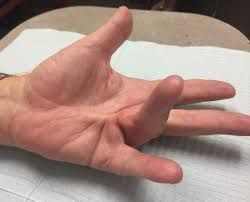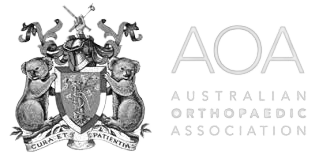Dupuytren's Contracture
What is Dupuytren’s Contracture?
Dupuytren’s Contracture is a hand condition that causes the fingers to curl inward and become bent. This condition affects the connective tissue of the hand, specifically the layer of tissue that lies beneath the skin of the palm and fingers. The affected tissue forms a thick, cord-like band that contracts, pulling the fingers inward and restricting their movement.
Dupuytren's Contracture is also known by other names such as Viking disease, palmar fibromatosis, and Dupuytren's disease.
How Does Dupuytren’s Contracture Impact Your Anatomy and Health?
Dupuytren’s Contracture impacts the hand's anatomy by causing the connective tissue to thicken and form a cord-like band, which pulls the fingers inward and restricts their movement.
Over time, this can cause significant disability and impact one’s ability to perform everyday tasks. For example, individuals with Dupuytren’s Contracture may have difficulty holding objects or performing manual labour.
Risk Factors and Causes of Dupuytren’s Contracture
There are several risk factors associated with Dupuytren's Contracture, including:
- Genetics: Dupuytren's Contracture tends to run in families, indicating a genetic component to the condition. Studies have identified several genes that may be involved in the development of the condition.
- Age: The risk of developing Dupuytren's Contracture increases with age, and the condition is more commonly observed in individuals over 50.
- Gender: Men are more likely to develop Dupuytren's Contracture than women, with a male-to-female ratio of 2:1.
- Ethnicity: Individuals of Northern European descent are at a higher risk of developing Dupuytren's Contracture than those of other ethnic backgrounds.
- Medical conditions: Certain conditions, such as diabetes, epilepsy, and alcoholism, have been associated with an increased risk of Dupuytren's Contracture.
- Lifestyle factors: Smoking and heavy alcohol consumption have also been identified as risk factors for Dupuytren's Contracture.
Symptoms of Dupuytren’s Contracture
The symptoms of Dupuytren's Contracture may vary in severity, depending on the stage of the condition. Some of the common symptoms of Dupuytren's Contracture include:
- Nodule or lump in the palm: This is often the first symptom of Dupuytren's Contracture, which may be tender or painful to the touch.
- Thickened cords in the hand: As the condition progresses, the nodules may evolve into thick cords that extend from the palm to the fingers, making it difficult to extend the fingers.
- Bending of the fingers: The fingers gradually become bent and may be difficult to straighten. The ring finger and little finger are most commonly affected, although the condition can also affect the middle finger.
- Difficulty with manual tasks: Individuals with Dupuytren's Contracture may experience difficulty with everyday tasks that require manual dexterity, such as holding objects, typing, or gripping.
- Puckering of the skin: In severe cases, the skin over the affected area may pucker or dimple, indicating a more advanced stage of the condition.
Phases of Dupuytren’s Contracture
Dupuytren's Contracture typically progresses through three phases, each characterised by the severity of the symptoms.
- Proliferative Phase: During the proliferative phase, there is an increase in the production of collagen in the palm, leading to the formation of nodules or lumps. The nodules may be tender or painful to the touch and gradually increase in size and density, forming thick cords extending from the palm to the fingers. This phase is also sometimes referred to as the active phase.
- Involution Phase: The involution phase is characterised by the gradual reduction in the size and number of nodules and cords. The cords may soften and become less dense, allowing for greater flexibility in the hand. This phase may last for several years and is also known as the quiescent phase.
- Residual Phase: During the residual phase, the nodules and cords have stabilised, but the finger contracture may remain. This phase is sometimes referred to as the residual phase, and the patient may require ongoing treatment to maintain hand function.
How is Dupuytren’s Contracture Diagnosed?
Dupuytren's Contracture is typically diagnosed through a physical hand examination by an orthopaedic surgeon. During the examination, the surgeon will assess the extent of the contracture and any associated nodules or cords. They may also ask about the patient's medical history and any family history of Dupuytren's Contracture.
To diagnose Dupuytren's Contracture, the surgeon will typically look for the following signs:
- Palpable nodules or lumps in the palm.
- Thickened cords of tissue in the palm, which may extend to the fingers.
- Finger contracture, which may be mild or severe and may affect one or more fingers.
- Difficulty with hand function or performing everyday tasks due to contracture.
Conservative Treatment Options
You may not need treatment for Dupuytren’s contracture if the condition is not affecting your ability to perform daily activities.
However, if you are experiencing pain or having difficulty using your hands for everyday activities, your surgeon will recommend conservative treatment options to treat your condition.
Treatment options will vary depending on the severity of the condition. The conservative approaches include:
- Heat: Applying heat to the palms of the hand before massage or exercise can help to loosen the tissues.
- Massage: Gently massage the thickened tissues of the palm.
- Exercises: Stretching exercises such as bending the fingers away from the palm may be useful.
- Injections: Steroid injections in the palm may be done to relieve local inflammation.
- Needle Aponeurotomy: This procedure involves inserting a small needle into the thickened palm tissue and manipulating it to loosen and break up the contracting tissue. Ultrasound may guide the needle to avoid hitting nerves or tendons.
- Collagenase Injection: An enzymatic drug that breaks down collagen can be injected into the corded tissue to soften and weaken the contracture. The physician then manipulates the tissue manually to break up the tissue.
Surgical Procedure for Dupuytren’s Contracture
Surgery is a treatment option for Dupuytren's Contracture when non-surgical methods have failed, or the condition has progressed to a severe stage. Surgery aims to release the contracted cords of tissue and restore hand function. Several surgical procedures are available to treat Dupuytren's Contracture, and the most appropriate procedure will depend on the extent and severity of the condition.
Some of the surgical procedures used for the treatment of Dupuytren's Contracture include:
- Fasciectomy: This is the most common surgical procedure for Dupuytren's Contracture. It involves making an incision in the skin and removing the affected tissue. A partial or complete fasciectomy may be performed depending on the extent of the condition. In a partial fasciectomy, only the affected tissue is removed, while in a complete fasciectomy, all of the tissue in the affected area is removed. After the procedure, the incision is closed with sutures, and the hand is placed in a splint or cast to promote healing.
- Needle Aponeurotomy: This minimally invasive surgical procedure involves inserting a small needle into the contracted cords of tissue and using it to release the tissue. This procedure is typically performed outpatient; the patient can resume normal activities shortly after.
- Dermofasciectomy: This is a more extensive surgical procedure that removes the affected tissue and the overlying skin. This procedure is typically reserved for severe cases of Dupuytren's Contracture.
- Enzymatic Fasciotomy: This new surgical technique involves injecting an enzyme into the contracted cords of tissue to dissolve the collagen and release the tissue. This procedure is still relatively new and has yet to be widely available.
After surgery, rehabilitation exercises may be prescribed to help restore hand function and promote healing. It is important to follow the surgeon's post-operative instructions to ensure a successful recovery.
What if Dupuytren’s Contracture is Untreated?
If left untreated, Dupuytren's Contracture can lead to the progressive bending of the fingers and a loss of hand function, significantly impacting the patient's quality of life.
Sometimes, the condition may stabilise or progress slowly without causing significant disability. In other cases, the contracture may become severe and impact the patient's ability to perform daily tasks or engage in activities they enjoy.
In addition to physical symptoms, untreated Dupuytren's Contracture can also cause emotional and psychological distress, especially if the condition affects the patient's ability to perform daily tasks or engage in activities they enjoy.
Furthermore, delaying treatment of Dupuytren's Contracture can lead to a higher risk of complications during surgical intervention if surgery becomes necessary.
Surgery may be required in cases where the condition has progressed to a severe stage and impacts the patient's quality of life. Delaying surgical treatment can result in increased scarring, longer recovery times, and decreased procedure effectiveness.



